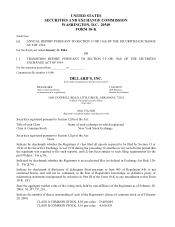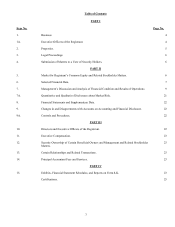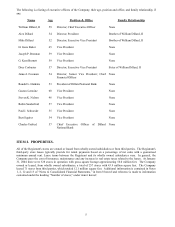Dillard's 2003 Annual Report Download - page 17
Download and view the complete annual report
Please find page 17 of the 2003 Dillard's annual report below. You can navigate through the pages in the report by either clicking on the pages listed below, or by using the keyword search tool below to find specific information within the annual report.Depreciation and amortization. Depreciation and amortization expenses include depreciation on property and
equipment and amortization of goodwill prior to February 3, 2002.
Rentals. Rentals include expenses for store leases and data processing equipment rentals.
Interest and debt expense. Interest and debt expense includes interest relating to the Company’s unsecured notes,
mortgage notes, credit card receivables financing, the Guaranteed Beneficial Interests in the Company’s subordinated
debentures, gains and losses on note repurchases, amortization of financing intangibles and interest on capital lease
obligations.
Asset impairment and store closing charges. Asset impairment and store closing charges consist of write-downs to
fair value of under-performing properties and exit costs associated with the closure of certain stores. Exit costs include
future rent, taxes and common area maintenance expenses from the time the stores are closed.
Cumulative effect of accounting change. Effective February 3, 2002, the Company adopted Statement of Financial
Accounting Standards (“SFAS”) No. 142, “Goodwill and Other Intangible Assets”. SFAS No. 142 changes the
accounting for goodwill from an amortization method to an “impairment only” approach. Under SFAS No. 142,
goodwill is no longer amortized but reviewed for impairment annually or more frequently if certain indicators arise. The
Company tested goodwill for impairment as of the adoption date using the two-step process prescribed in SFAS No. 142.
The Company identified its reporting units under SFAS No. 142 at the store unit level. The fair value of these reporting
units was estimated using the expected discounted future cash flows and market values of related businesses, where
appropriate. The cumulative effect of the accounting change as of February 3, 2002 was to decrease net income for fiscal
year 2002 by $530 million or $6.22 per diluted share.
Critical Accounting Policies and Estimates
The Company’s accounting policies are more fully described in Note 1of Notes to Consolidated Financial Statements.
As disclosed in Note 1 of Notes to Consolidated Financial Statements, the preparation of financial statements in
conformity with accounting principles generally accepted in the United States of America (“GAAP”) requires
management to make estimates and assumptions about future events that affect the amounts reported in the consolidated
financial statements and accompanying notes. Since future events and their effects cannot be determined with absolute
certainty, actual results will differ from those estimates. The Company evaluates its estimates and judgments on an
ongoing basis and predicates those estimates and judgments on historical experience and on various other factors that are
believed to be reasonable under the circumstances. Actual results will differ from these under different assumptions or
conditions.
Management of the Company believes the following critical accounting policies, among others, affect its more
significant judgments and estimates used in preparation of the Consolidated Financial Statements.
Merchandise inventory. Approximately 97% of the inventories are valued at lower of cost or market using the retail
last-in, first-out (“LIFO”) inventory method. Under the retail inventory method (“RIM”), the valuation of inventories at
cost and the resulting gross margins are calculated by applying a calculated cost to retail ratio to the retail value of
inventories. RIM is an averaging method that has been widely used in the retail industry due to its practicality.
Additionally, it is recognized that the use of RIM will result in valuing inventories at the lower of cost or market if
markdowns are currently taken as a reduction of the retail value of inventories. Inherent in the RIM calculation are
certain significant management judgments including, among others, merchandise markon, markups, and markdowns,
which significantly impact the ending inventory valuation at cost as well as the resulting gross margins. Management
believes that the Company’s RIM provides an inventory valuation which results in a carrying value at the lower of cost
or market. The remaining 3% of the inventories are valued at lower of cost or market using the specific identified cost
method.
Allowance for doubtful accounts. The accounts receivable from the Company’s proprietary credit card sales are
subject to credit losses. The Company maintains allowances for uncollectible accounts for estimated losses resulting
from the inability of its customers to make required payments. The adequacy of the allowance is based on historical
experience with similar customers including write-off trends, current aging information and year-end balances.
Bankruptcies and recoveries used in the allowance calculation are projected based on qualitative factors such as current
and expected consumer and economic trends. Management believes that the allowance for uncollectible accounts is
adequate to cover anticipated losses in the reported credit card receivable portfolio under current conditions; however,
significant deterioration in any of the above-noted factors or in the overall health of the economy could materially change
these expectations.
11
























